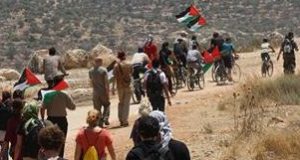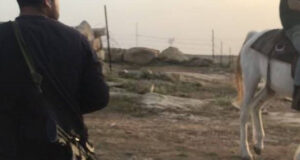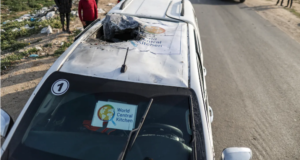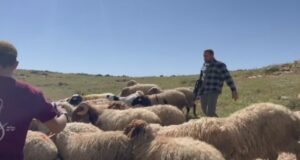by Adam Shapiro
Originally published in The Nation
The International Solidarity Movement’s second Freedom Summer has begun, and much has changed since our last: the war on Iraq, which focused all eyes on the region; the much-hyped road map; full-blown construction on what Palestinians have come to call the Apartheid Wall. Sadly, though, much remains the same: the continuing deterioration of the lives of Palestinians, with poverty and health crises in a crescendo.
The ISM itself is in a far more precarious position. This year, volunteers signed up knowing that one ISMer was killed, that others have been shot, expelled or detained. They knew that the ISM headquarters was raided in May, that the Israel Defense Forces (IDF) instituted new regulations barring the ISM from entering Gaza. They knew that the military sought to smear the ISM by claiming it has links to terrorists. And still people from all over the world have come, in record numbers, to volunteer.
The ISM was founded a few months into the current intifada to engage in nonviolent action against the Israeli occupation. The idea, inspired by the Freedom Rides of the American civil rights movement, was that international civilians could provide a resource for the Palestinian nonviolent struggle-and that their eyewitness accounts of the occupation could affect political debate back home. With internationals mixed in with Palestinian civilians at protests, we believed that Israeli soldiers would be more reluctant to use lethal force. These efforts worked, at least at first. Not that violence was eliminated-tear gas, sound grenades and rubber bullets were still used against Palestinians. But mostly, live ammunition was avoided around internationals, and rubber bullets weren’t fired at head or chest level. Last August, for example, I joined 200 Palestinians in a peaceful march near Nablus to break the curfew there. With forty internationals in the crowd, the IDF relied on tear gas and sound grenades, firing only a few rubber bullets into the air. When one soldier fired a rubber bullet lower, into the crowd, I saw one of his superiors grab his gun and berate him. The message was clear: Israeli soldiers respected the lives of international civilians more than Palestinian lives. We, unlike the Palestinians, had governments that could hold Israel accountable-or so we thought.
Then in March, Rachel Corrie was crushed to death by an Israeli bulldozer in Rafah. In early April, Brian Avery was shot in the face in Jenin by patrolling Israeli troops. Less than a week later Tom Hurndall was shot in the head by an Israeli sniper in Rafah. All three had taken precautions, identifying themselves as international observers to IDF soldiers, wearing fluorescent orange vests. They had put themselves in danger only to the extent that all Palestinian civilian areas were in the path of a deepening Israeli military occupation. In the four months since Rachel’s death, more than 200 Palestinians have been killed, most of them noncombatants, in Israeli attacks.
The assaults on these activists stunned the ISM. But they had little effect on most Americans. Perhaps it was the poor media coverage or the distraction of the war on Iraq-or perhaps we have just gotten used to seeing the victims of Israeli violence as in some way to blame for their own victimization. Although witnesses say that Rachel was deliberately run over, the IDF quickly claimed that the driver was not at fault, and he has remained on the job without suspension. So even if Rachel’s killing was accidental, future attacks would be less so. In a recent e-mail to the ISM, an Israeli soldier wrote that while the IDF determination was by no means a “direct order to shoot at internationals, it sent the message that it would be OK.” Within weeks, if the shootings of Tom and Brian are any indication, soldiers got the message. Brian came home to Chapel Hill in June severely disfigured; Tom arrived home to Manchester, England, in a coma, unlikely to recover. It seems that internationals now face from the IDF something close to the callous disregard for life that Palestinians experience every day.
According to the Geneva Conventions, civilians under occupation are to be protected by the occupying power. When Israel revokes these protections even for international civilians, it is a sign that such protections have been utterly dispensed with for local residents. It is routine in this occupation for Palestinian homes to be destroyed, trees and agricultural fields to be torn up, land confiscated for the building of ever more settlements and Palestinians denied access to education and healthcare.
It’s time for the international community to step in to guarantee the safety of international observers and of Palestinians themselves. To start, British and US governments must conduct investigations into the attacks on their citizens. These investigations should go beyond the specifics of each case, to determine acceptable rules of engagement for Israeli soldiers when civilians-international or Palestinian-are present. They could expose the links between basic Israeli policies of occupation and the death and injury of Palestinian civilians-policies like home demolition and rules that allow Israeli soldiers to shoot first and ask questions later, if at all. In Rachel’s case, an investigation would undoubtedly uncover the illegal use of US-supplied weaponry. The armored bulldozer that crushed Rachel was a Caterpillar, and was being used to demolish Palestinian homes-a likely violation of the US Arms Export Control Act, which prohibits the use of US-supplied weaponry against civilians. The use of all US weapons, from F-16s to Apache helicopters, could thus come under scrutiny, perhaps finally forcing Washington to make the sale of weapons to Israel conditional on their legitimate use-effectively undermining Israel’s ability to enforce its occupation.
Despite threats of violence, volunteers from around the world, of all ages, ethnicities and faiths, have now arrived in the occupied territories for Freedom Summer, even as diplomats urge cooperation with a road map that fatally accepts many aspects of the occupation as legitimate. These volunteers share an understanding that the biggest obstacle to peace is the occupation itself, solidified by Israel’s “facts on the ground”: checkpoints, settlements, bypass roads, military bases and “closed military zones.” The newest “fact” (unremarked in the road map) is the Apartheid Wall, which will annex some 10 percent of West Bank land and rob many West Bank towns of their only water source. If completed, it will extend more than 350 kilometers, cut off 72,000 farmers from their land and trap 140,000 villagers between the wall and the Green Line. This summer, the wall is our target: the ISM is working with local communities to tear it down, one piece at a time. We are pressing not just for a Palestinian state but for the future viability of the Palestinian people on their land.
 International Solidarity Movement Nonviolence. Justice. Freedom.
International Solidarity Movement Nonviolence. Justice. Freedom.



